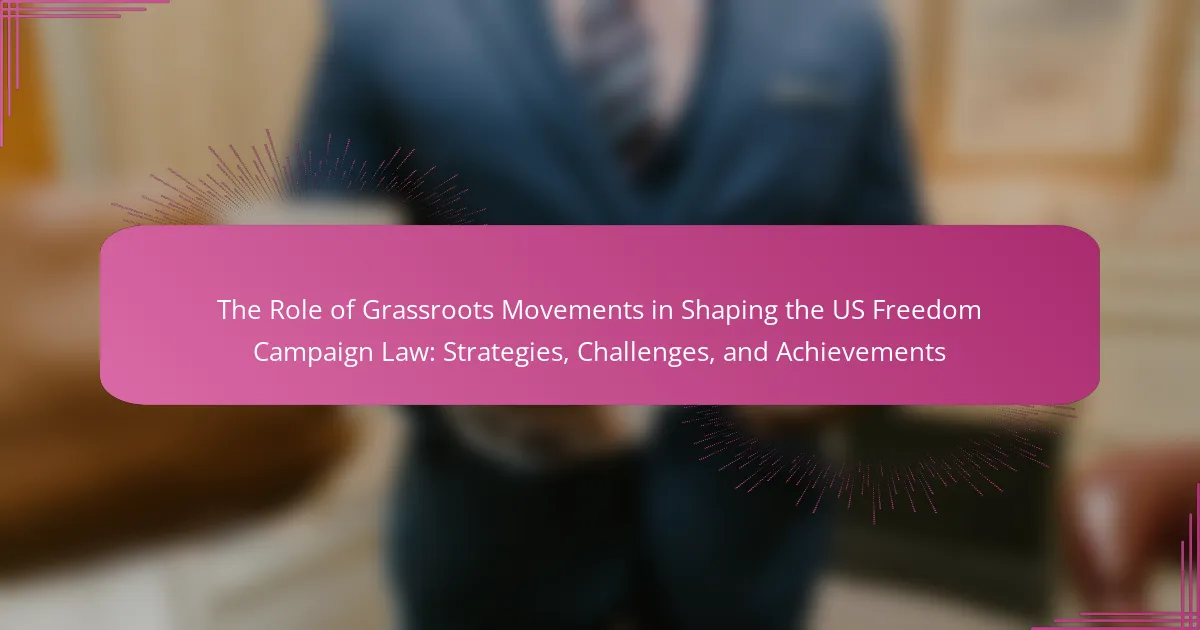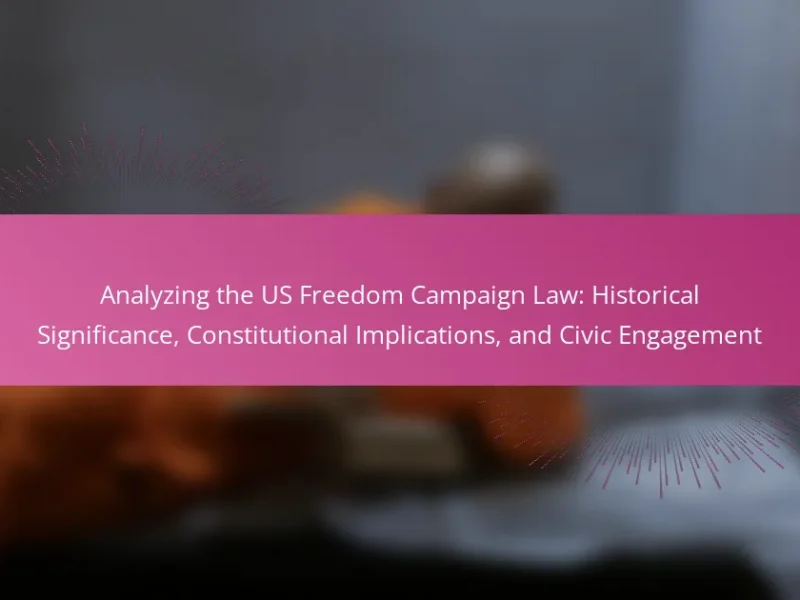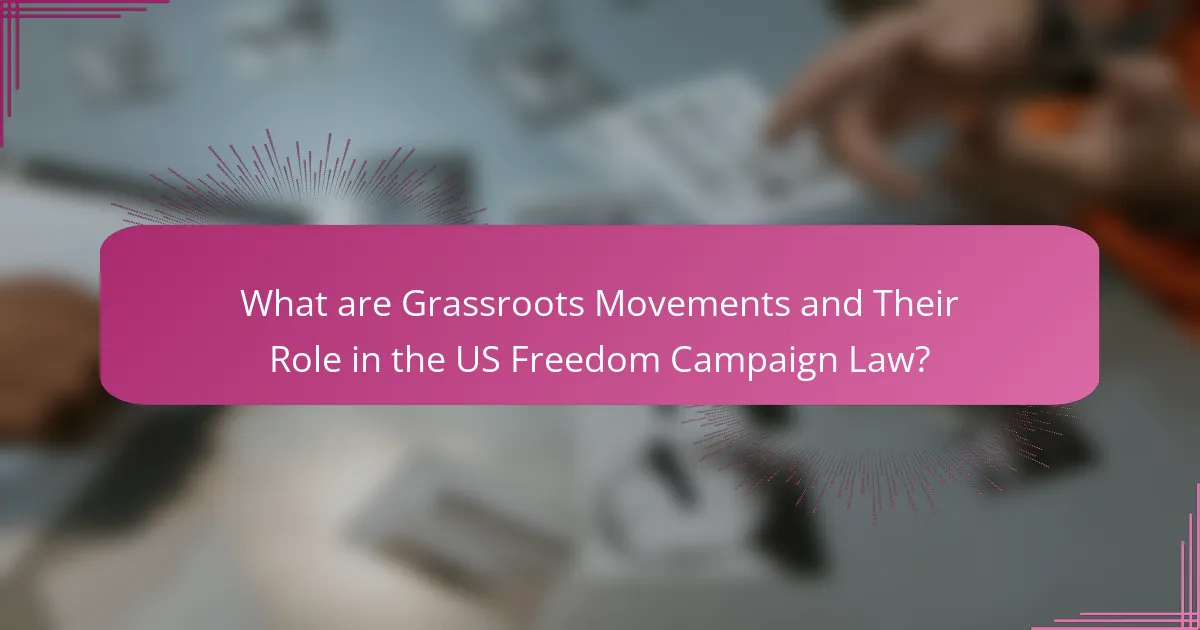
What are Grassroots Movements and Their Role in the US Freedom Campaign Law?
Grassroots movements are organized efforts by ordinary people to effect social or political change. In the context of the US Freedom Campaign Law, these movements play a crucial role in advocating for reforms. They mobilize communities to raise awareness about issues such as voting rights and campaign finance. Grassroots movements often utilize strategies like petitions, rallies, and social media campaigns to amplify their message. Their influence is evident in significant legislation driven by public demand. For example, the Voting Rights Act of 1965 was largely a result of grassroots activism. Overall, grassroots movements are essential in shaping policies and laws that reflect the will of the people.
How do grassroots movements influence legislative change?
Grassroots movements influence legislative change by mobilizing public support and advocating for specific policies. They raise awareness about social issues through campaigns and community organizing. This grassroots activism often leads to increased voter engagement and pressure on lawmakers. For example, the Civil Rights Movement in the 1960s successfully lobbied for the Voting Rights Act. Similarly, the Women’s March in 2017 galvanized millions to advocate for women’s rights legislation. Research indicates that grassroots efforts can significantly impact legislative agendas by shifting public opinion. Studies show that movements with strong community backing can lead to tangible policy changes.
What historical examples illustrate the impact of grassroots movements?
The Civil Rights Movement is a prominent example of grassroots impact. Activists organized protests, sit-ins, and marches to demand equal rights. The Montgomery Bus Boycott in 1955 led to a Supreme Court ruling against segregation. The movement’s grassroots nature mobilized communities across the nation. Another example is the Women’s Suffrage Movement. Grassroots efforts resulted in the 19th Amendment, granting women the right to vote in 1920. The anti-Vietnam War protests also showcased grassroots mobilization. These movements influenced public opinion and policy changes. Each example highlights the power of collective action in shaping societal norms and laws.
How do grassroots movements mobilize community support?
Grassroots movements mobilize community support by fostering local engagement and collective action. They utilize social media platforms to spread awareness and connect with community members. Organizing events and rallies helps to galvanize public interest and participation. These movements often focus on shared values and common goals to unite diverse groups. They provide resources and training to empower individuals to take action. Collaborating with local organizations strengthens their outreach and effectiveness. Historical examples, like the Civil Rights Movement, demonstrate the power of grassroots mobilization in achieving significant social change. Data shows that grassroots initiatives can lead to increased voter turnout and community involvement in civic matters.
What strategies do grassroots movements employ in shaping legislation?
Grassroots movements employ several strategies to shape legislation. They often focus on community organizing to raise awareness and mobilize support. This includes building coalitions with like-minded organizations. They utilize social media to amplify their message and reach a broader audience. Grassroots movements also engage in direct lobbying of legislators to influence policy decisions. They conduct public demonstrations to draw attention to their causes. Additionally, they gather signatures for petitions to show public support for specific legislation. These strategies have been effective in various historical contexts, such as the Civil Rights Movement and environmental advocacy.
What types of advocacy techniques are commonly used?
Commonly used advocacy techniques include grassroots mobilization, lobbying, and public awareness campaigns. Grassroots mobilization involves organizing community members to participate in advocacy efforts. This technique increases public engagement and support for specific causes. Lobbying focuses on influencing policymakers directly through meetings and discussions. It aims to shape legislation and gain support for specific issues. Public awareness campaigns utilize media and communication strategies to inform and educate the public. These campaigns can raise visibility and generate support for advocacy goals. Research indicates that these techniques are effective in driving social change and influencing policy decisions.
How do grassroots movements utilize social media for outreach?
Grassroots movements utilize social media for outreach by creating awareness and mobilizing supporters. They leverage platforms like Facebook, Twitter, and Instagram to disseminate information rapidly. These movements often share compelling stories and visuals to engage audiences emotionally. They also use hashtags to unify messages and increase visibility. Social media allows for real-time communication and updates, fostering a sense of community among supporters. Additionally, grassroots movements can organize events and campaigns through social media, facilitating participation. According to a study by the Pew Research Center, 69% of adults in the U.S. use social media, highlighting its potential reach for grassroots initiatives.
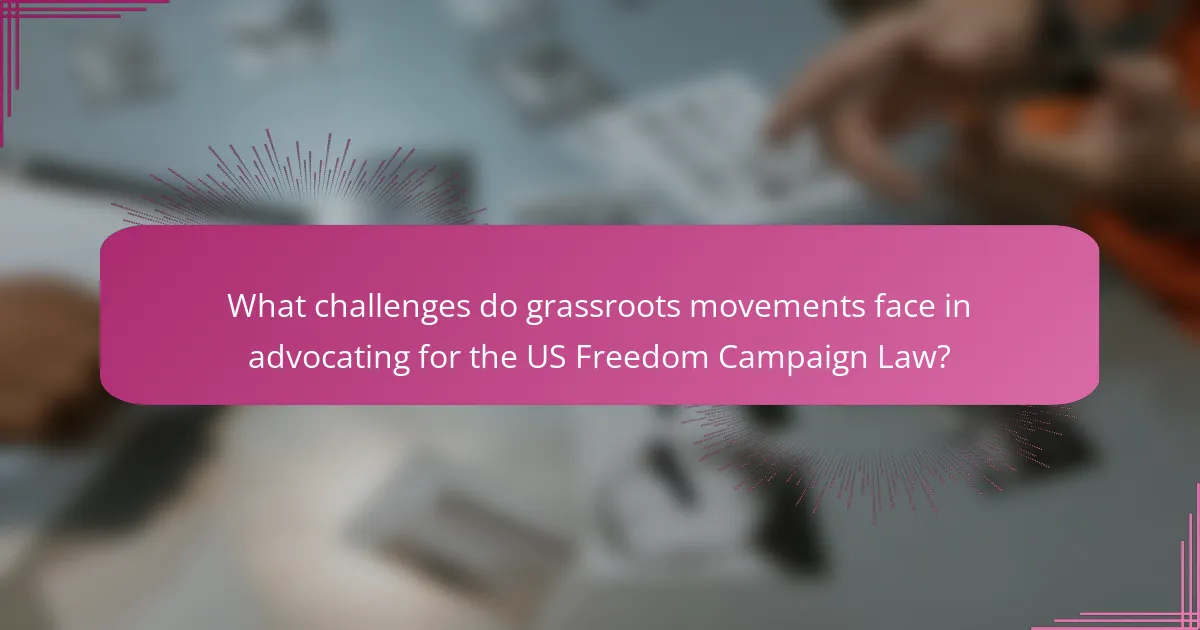
What challenges do grassroots movements face in advocating for the US Freedom Campaign Law?
Grassroots movements face significant challenges in advocating for the US Freedom Campaign Law. Limited funding restricts their ability to mobilize resources effectively. Competing interests from well-funded organizations often overshadow grassroots efforts. Additionally, grassroots movements frequently encounter political resistance from established power structures. Lack of media coverage can diminish their visibility and influence. Internal conflicts may arise over strategy and priorities, leading to fragmentation. Furthermore, the complexity of legislative processes can hinder their advocacy efforts. These factors collectively impede the effectiveness of grassroots movements in promoting the US Freedom Campaign Law.
What obstacles hinder grassroots movements in achieving their goals?
Grassroots movements face several obstacles in achieving their goals. Limited funding restricts their ability to mobilize resources effectively. Many grassroots organizations struggle to gain media attention, which hinders their outreach. Additionally, bureaucratic barriers can impede their progress in influencing policy. Internal conflicts within movements can also create divisions, weakening their collective efforts. Furthermore, opposition from established political entities often poses significant challenges. The lack of a unified strategy can lead to fragmented initiatives, reducing overall impact. These factors collectively undermine the effectiveness of grassroots movements in driving change.
How does funding affect grassroots advocacy efforts?
Funding significantly influences grassroots advocacy efforts. It determines the resources available for outreach, mobilization, and campaign activities. Adequate funding enables organizations to hire staff, develop materials, and conduct events. For instance, a study by the National Committee for Responsive Philanthropy found that well-funded grassroots groups can increase their outreach by 50%. This financial support enhances visibility and engagement with the community. Conversely, limited funding constrains these efforts, reducing impact and reach. Historical examples show that movements with substantial funding, like the Civil Rights Movement, achieved significant legislative changes. Thus, funding is a crucial factor in the success of grassroots advocacy.
What role does public perception play in grassroots movement success?
Public perception is crucial for the success of grassroots movements. It influences support, funding, and media coverage. Positive public perception can lead to increased participation and volunteerism. When the public views a movement favorably, it attracts attention from policymakers. This attention can translate into legislative changes or financial backing. For instance, the Civil Rights Movement gained momentum due to widespread public support in the 1960s. Events like the March on Washington highlighted the movement’s goals to a national audience. Research shows that movements with strong public backing are more likely to succeed in achieving their objectives.
How do grassroots movements navigate political opposition?
Grassroots movements navigate political opposition through strategic organization and coalition building. They mobilize community support to amplify their voices. Effective communication is vital for conveying their message and goals. Grassroots activists often utilize social media to reach broader audiences quickly. They engage in peaceful protests to draw attention to their causes. Legal strategies, such as filing lawsuits, can challenge unjust laws or practices. Collaborating with established organizations enhances their influence and resources. Historical examples include the Civil Rights Movement, which effectively challenged systemic racism through grassroots efforts.
What strategies are effective in overcoming political barriers?
Effective strategies for overcoming political barriers include building coalitions and fostering collaboration. Grassroots movements often unite diverse groups to amplify their voices. Engaging in advocacy and lobbying efforts can also influence policymakers. Public awareness campaigns raise visibility and support for issues. Utilizing social media enhances outreach and mobilizes supporters quickly. Education and information dissemination empower communities to challenge political obstacles. Historical examples, such as the Civil Rights Movement, demonstrate the power of these strategies in effecting change.
How do grassroots movements build coalitions to strengthen their impact?
Grassroots movements build coalitions by forming alliances with like-minded organizations and individuals. They identify shared goals and values to create a unified front. This collaboration enhances resource sharing, increasing overall effectiveness. Grassroots movements often engage in community outreach to involve diverse stakeholders. They utilize social media to amplify their message and attract supporters. By organizing events, they foster connections among coalition members. These strategies have been effective in past movements, such as the Civil Rights Movement. The formation of coalitions has historically led to significant legislative changes and social progress.
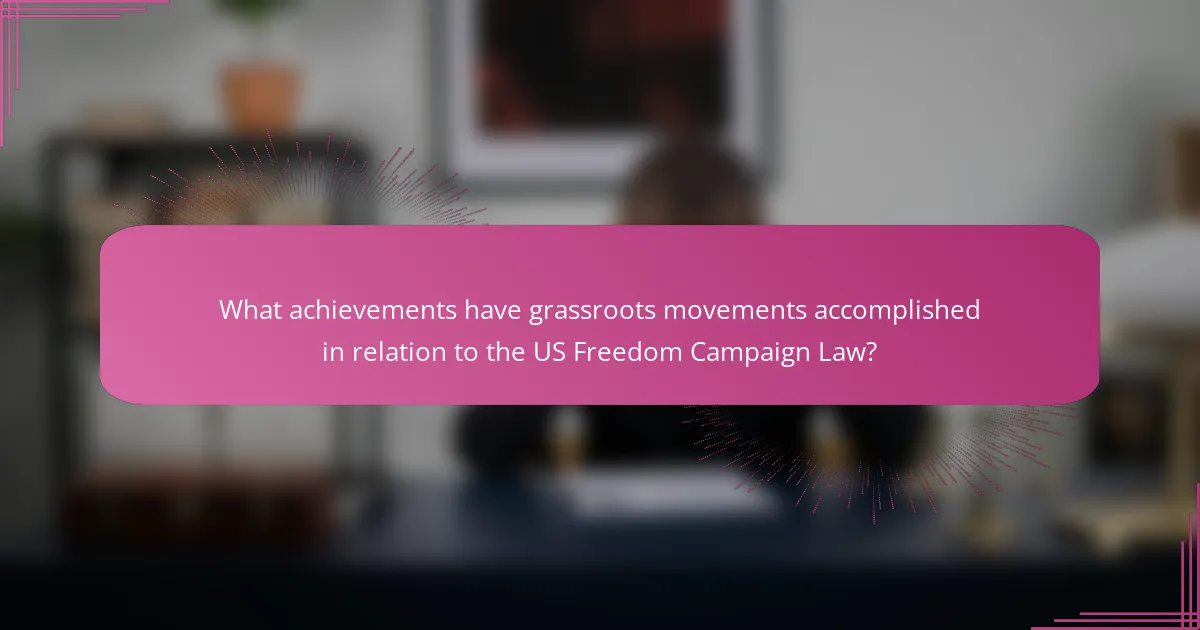
What achievements have grassroots movements accomplished in relation to the US Freedom Campaign Law?
Grassroots movements have successfully influenced the US Freedom Campaign Law by advocating for campaign finance reform. They have raised awareness about the impact of money in politics. These movements mobilized public support for legislation aimed at increasing transparency in campaign financing. They also played a role in pushing for the establishment of stricter regulations on political donations. Notable achievements include the introduction of measures to limit contributions from corporations and foreign entities. Additionally, grassroots efforts contributed to the passage of laws requiring disclosure of campaign ad sponsors. These accomplishments demonstrate the power of collective action in shaping legislative outcomes.
What milestones have been reached through grassroots advocacy?
Grassroots advocacy has achieved significant milestones, including the passage of key legislation. One notable example is the Civil Rights Act of 1964, which was influenced by grassroots campaigns. These campaigns mobilized communities to demand equality and justice. Another milestone is the Voting Rights Act of 1965, which aimed to eliminate racial discrimination in voting. Grassroots organizations played a crucial role in raising awareness and organizing protests. Additionally, the Women’s March in 2017 showcased the power of grassroots mobilization for women’s rights. These milestones demonstrate the effectiveness of grassroots efforts in shaping policy and societal change.
How have grassroots movements influenced key legislation outcomes?
Grassroots movements have significantly influenced key legislation outcomes through mobilization and advocacy. These movements often raise awareness about specific issues, creating public pressure for change. For example, the Civil Rights Movement in the 1960s led to the passage of the Civil Rights Act of 1964. Activists organized protests and campaigns that highlighted racial injustices, compelling lawmakers to act.
Additionally, grassroots campaigns have utilized social media to amplify their messages and reach wider audiences. The Women’s March in 2017 mobilized millions, influencing discussions around women’s rights and leading to legislative proposals like the Paycheck Fairness Act.
Research indicates that grassroots lobbying efforts can sway legislators by demonstrating widespread public support. According to a study by the Center for American Progress, 70% of lawmakers reported being influenced by constituent outreach. This underscores the power of grassroots movements in shaping legislative agendas and outcomes.
What success stories highlight the effectiveness of grassroots strategies?
Grassroots strategies have led to significant successes in various movements. One notable example is the Civil Rights Movement. Activists organized local communities to demand equal rights. Their efforts resulted in landmark legislation like the Civil Rights Act of 1964. Another success story is the environmental movement. Grassroots organizations mobilized citizens to advocate for policies like the Clean Air Act. This led to substantial improvements in air quality across the United States. Additionally, the women’s suffrage movement showcases grassroots effectiveness. Local groups campaigned tirelessly for voting rights, culminating in the 19th Amendment in 1920. These examples illustrate how grassroots strategies can drive meaningful change.
What lessons can be learned from grassroots movements in shaping the US Freedom Campaign Law?
Grassroots movements have significantly influenced the shaping of the US Freedom Campaign Law. One key lesson is the power of collective action. Mobilizing communities can amplify voices and drive legislative change. Another lesson is the importance of grassroots advocacy in raising awareness. Campaigns often highlight issues that may be overlooked by traditional political entities. Additionally, grassroots movements demonstrate the effectiveness of local engagement. Local leaders can connect with constituents, fostering trust and support. The role of social media is also crucial. It allows movements to organize quickly and spread their message widely. Finally, persistence is vital. Many successful campaigns took years of sustained effort to achieve their goals. These lessons illustrate how grassroots movements can effectively shape significant legislation.
How can future grassroots movements apply these lessons?
Future grassroots movements can apply these lessons by leveraging community engagement strategies. Effective communication is essential for mobilizing support. Utilizing social media platforms can amplify their message and reach wider audiences. Building coalitions with existing organizations enhances resource sharing and strengthens advocacy efforts. Training leaders within the community fosters sustainable leadership and empowers participants. Documenting successes and challenges provides valuable insights for future initiatives. Historical examples, such as the Civil Rights Movement, demonstrate the impact of organized grassroots efforts on legislation. These strategies can lead to more effective campaigns and influence policy changes.
What best practices should be adopted for successful advocacy?
Successful advocacy requires clear messaging and strong community engagement. Clear messaging ensures that the goals and values of the advocacy are easily understood by the audience. Strong community engagement builds trust and mobilizes support.
Building coalitions with like-minded organizations amplifies advocacy efforts. This collaborative approach can pool resources and expertise. Utilizing social media effectively spreads awareness and mobilizes grassroots support.
Regularly measuring the impact of advocacy activities helps in adjusting strategies. Data-driven insights can guide future efforts and improve effectiveness. Engaging with policymakers through direct communication fosters relationships and influences decision-making.
Transparency in actions and finances builds credibility. This credibility is essential for maintaining public trust and support. Advocacy that includes diverse voices and perspectives strengthens its impact and reach.
The main entity of the article is grassroots movements and their influence on the US Freedom Campaign Law. The article examines how these movements advocate for social and political reforms, particularly in areas such as voting rights and campaign finance. It outlines the strategies employed by grassroots activists, the challenges they face, and historical examples of their impact on legislation, including the Civil Rights Movement and the Women’s Suffrage Movement. Additionally, the article highlights the significance of funding, public perception, and coalition-building in enhancing the effectiveness of grassroots advocacy efforts.
